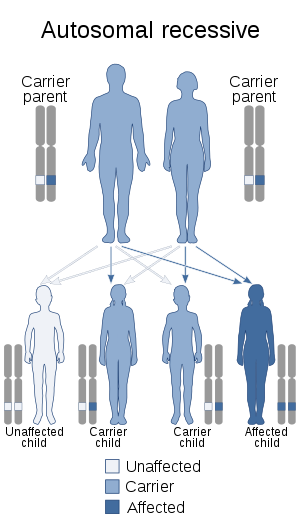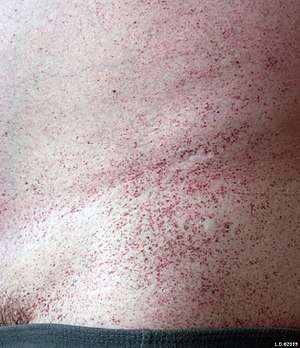Beta-mannosidosis
Beta-mannosidosis, also called lysosomal beta-mannosidase deficiency,[5] is a disorder of oligosaccharide metabolism caused by decreased activity of the enzyme beta-mannosidase. This enzyme is coded for by the gene MANBA, located at 4q22-25. Beta-mannosidosis is inherited in an autosomal recessive manner.[5] Affected individuals appear normal at birth, and can have a variable clinical presentation. Infantile onset forms show severe neurodegeneration, while some children have intellectual disability. Hearing loss and angiokeratomas are common features of the disease.[3][2]
| Beta-mannosidosis | |
|---|---|
| Other names | Beta-mannosidase deficiency, MANSB |
 | |
| This condition is autosomal recessive in inheritance | |
| Specialty | Medical genetics |
| Symptoms | Respiratory infections, Hearing loss and Intellectual disability.[1] |
| Causes | Mutations in the MANBA gene[2] |
| Diagnostic method | Urine test[3] |
| Treatment | Based on symptoms[4] |
Symptoms and signs

The initial affected individual described in 1986 had a complex phenotype, and was later found to have both beta-mannosidosis and Sanfilippo syndrome.[5] People have been described with a wide spectrum of clinical presentations from infants and children with intellectual disability to adults who present with isolated skin findings (angiokeratomas).[5]
Most cases are identified in the first year of life with respiratory infections, hearing loss and intellectual disability. Because of its rarity, and non-specific clinical findings, beta-mannosidosis can go undiagnosed until adulthood, where it can present with intellectual disability and behavioral problems, including aggression.[6][1]
Cause
In terms of causation several mutations in the MANBA gene is the cause of beta-mannosidosis. The cytogenetic location of the gene is 4q24, furthermore the condition is inherited in an autosomal recessive manner[7][2]
Mechanism
The pathophysiology of this condition, is better comprehended, if one first looks at the normal function of beta-mannosidase such as its function of breaking down disaccharides
Beta-mannosidase function is consistent with, it being a lysosomal enzyme catalyzing and thus involved in degradation route for N-linked oligosaccharide moieties(glycoproteins)[8]
Diagnosis
A diagnosis of beta-mannosidosis is suspected based on the persons clinical presentation. Urine testing to identify abnormal oligosaccharides is a useful screening test, and enzymatic analysis or molecular testing can be used for confirmation.[3]
Differential diagnosis
Diagnostic techniques for this condition can be done to offer a DDx, via lectin histochemistry to distinguish between α-mannosidosis and beta-mannosidosis.[9]
Treatment
In terms of beta-mannosidosis treatment there is none currently, individuals that exhibit muscle weakness or seizures are treated based on the symptoms (since there's no cure)[4]
See also
References
- "Mannosidosis, beta A, lysosomal | Genetic and Rare Diseases Information Center (GARD) – an NCATS Program". rarediseases.info.nih.gov. Retrieved 2017-07-13.
- Reference, Genetics Home. "beta-mannosidosis". Genetics Home Reference. Retrieved 2017-07-13.
- Enns, Gregory M.; Steiner, Robert D.; Cowan, Tina M. (2009). "Lysosomal Disorders". In Sarafoglou, Kiriakie; Hoffmann, Georg F.; Roth, Karl S. (eds.). Pediatric Endocrinology and Inborn Errors of Metabolism (1st ed.). New York: McGraw-Hill Medical. pp. 721–755. ISBN 978-0-07-143915-2.
- Kelly, Evelyn B. (2013). Encyclopedia of Human Genetics and Disease. ABC-CLIO. p. 514. ISBN 9780313387135. Retrieved 10 December 2017.
- Online Mendelian Inheritance in Man (OMIM): 248510
- Sedel, F.; Baumann, N.; Turpin, J. -C.; Lyon-Caen, O.; Saudubray, J. -M.; Cohen, D. (2007). "Psychiatric manifestations revealing inborn errors of metabolism in adolescents and adults". Journal of Inherited Metabolic Disease. 30 (5): 631–641. doi:10.1007/s10545-007-0661-4. PMID 17694356.subscription required
- Reference, Genetics Home. "MANBA gene". Genetics Home Reference. Retrieved 2017-10-25.
- "OMIM Entry - * 609489 - MANNOSIDASE, BETA A, LYSOSOMAL; MANBA". www.omim.org. Retrieved 9 May 2018.
- Johnson, William (2015). Rosenberg's Molecular and Genetic Basis of Neurological and Psychiatric Disease (Fifth Edition). Academic Press. pp. 369–383. ISBN 978-0-12-410529-4.
Further reading
- Molho-Pessach, Vered; Bargal, Ruth; Abramowitz, Yigal; Doviner, Victoria; Ingber, Arieh; Raas-Rothschild, Annick; Ne'eman, Zvi; Zeigler, Marsha; Zlotogorski, Abraham (2007). "Angiokeratoma corporis diffusum in human beta-mannosidosis: Report of a new case and a novel mutation". Journal of the American Academy of Dermatology. 57 (3): 407–412. doi:10.1016/j.jaad.2007.01.037. ISSN 1097-6787. PMID 17420068.
- Huynh, T; Khan, JM; Ranganathan, S (30 November 2011). "A comparative structural bioinformatics analysis of inherited mutations in β-D-Mannosidase across multiple species reveals a genotype-phenotype correlation". BMC Genomics. 12 Suppl 3: S22. doi:10.1186/1471-2164-12-S3-S22. ISSN 1471-2164. PMC 3333182. PMID 22369051.
External links
| Classification | |
|---|---|
| External resources |
